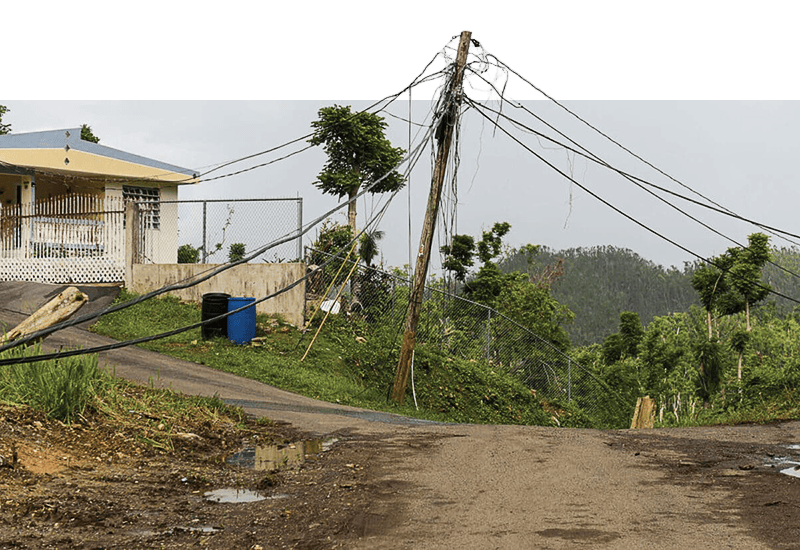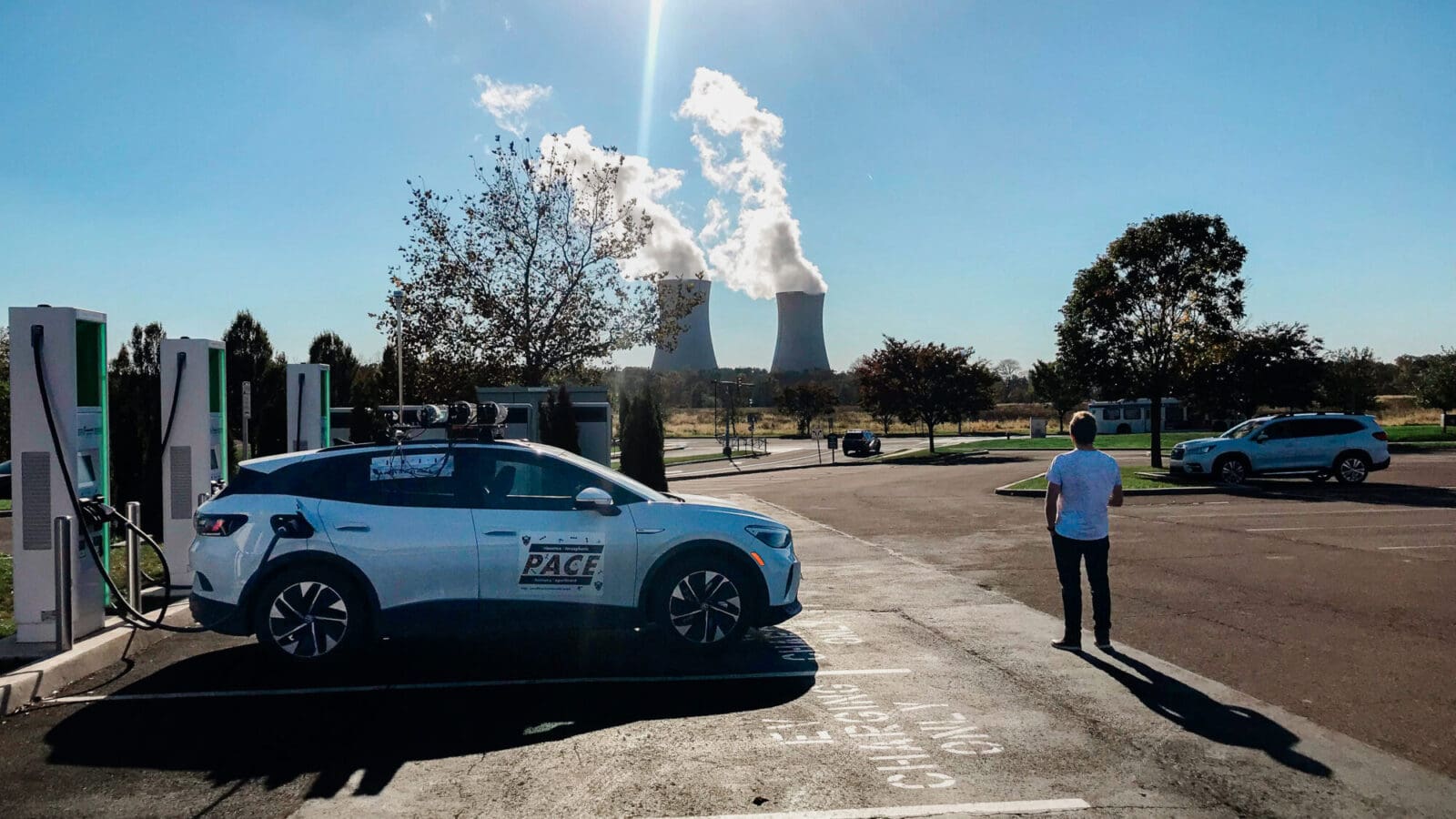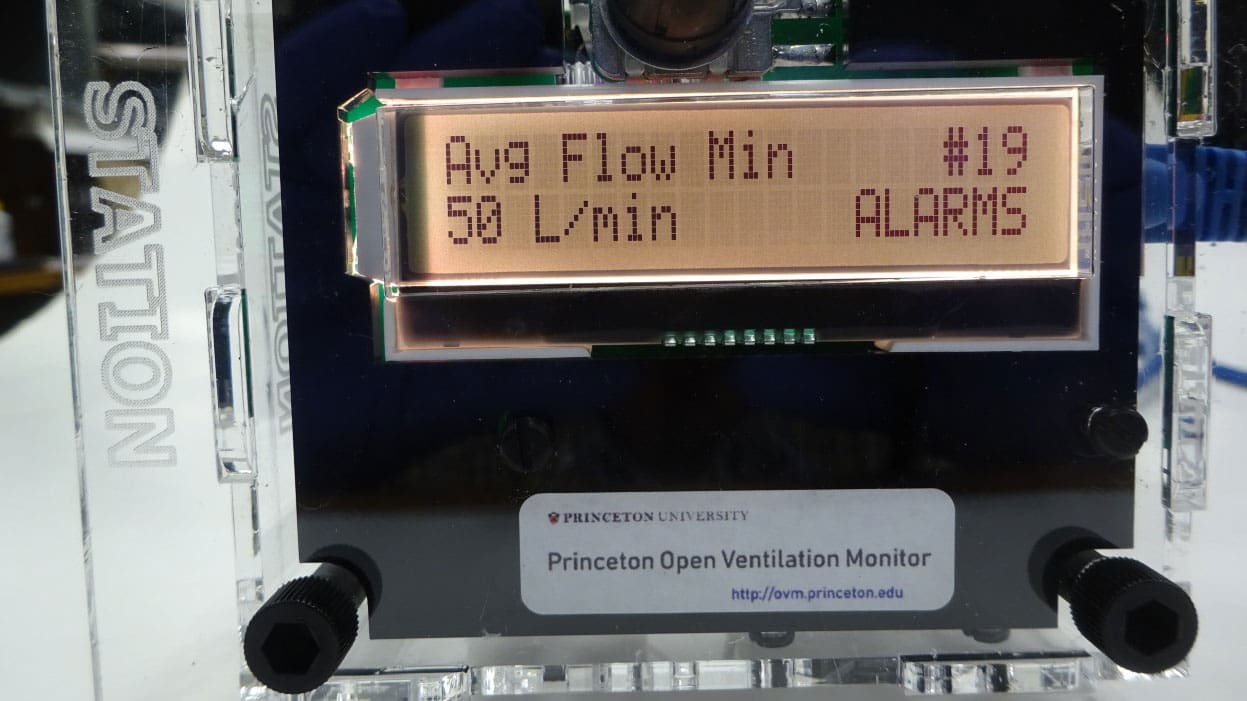
‘In times of great need,’ collaboration yields breathing system to assist COVID-19 patients
By
on
This is from the series COVID-19 Research and Service
Penn Medicine, which runs hospitals in Pennsylvania and New Jersey, needed specialized machines to monitor the breathing patterns and flow of oxygen to patients undergoing non-invasive ventilation, a form of respiratory support that is gentler on the lungs and has caught on in popularity during the crisis. The hospitals needed the machines to meet exacting standards, and they needed them fast. Plus, there was a catch. Parts used to build the devices were nearly impossible to find. So Leifer and his colleagues at Princeton would have to improvise.
They did. In a few weeks, a collection of researchers, professors, technicians, graduate students and staffers designed, prototyped and tested the new machine. The created new supply chains for re-purposed parts, fine-tuned subsystems in the labs of Princeton’s materials institute and built the new machines in Jadwin Hall. Within a month, the team had produced 50 of them.
“The goal is to help patients with COVID-19, and to be able to work toward that goal was just tremendous,” said Leifer, an assistant professor of physics and neuroscience. “We have had involvement at all levels: faculty, students, postdocs, staff. It’s amazing.”
Since the pandemic shut down much of the country, the Princeton community has responded in many ways to help battle the disease. Researchers have re-focused their efforts, staff members have routed emergency supplies to hospitals, students and faculty have made protective equipment for medical workers. Physics Professor Cristiano Galbiati led an international effort to design and produce emergency ventilators. Daniel Cohen, an assistant professor of mechanical and aerospace engineering, coordinated teams of colleagues and students who supplied face shields and other protective gear to area hospitals.
The effort to build these respiratory monitoring systems had a similar start.
“Princeton is a small world, and through my wife, who works in industry, I got in contact with Jake Brenner at Penn, a world expert in acute respiratory distress syndrome at the Hospital of the University of Pennsylvania,” Leifer said. Brenner is part of the Penn Health Tech — an interdisciplinary center that spans Penn’s Perelman School of Medicine and the School of Engineering and Applied Sciences — and chaired an emergency ventilator task force of scientists and engineers to try to meet the demands of the crisis.
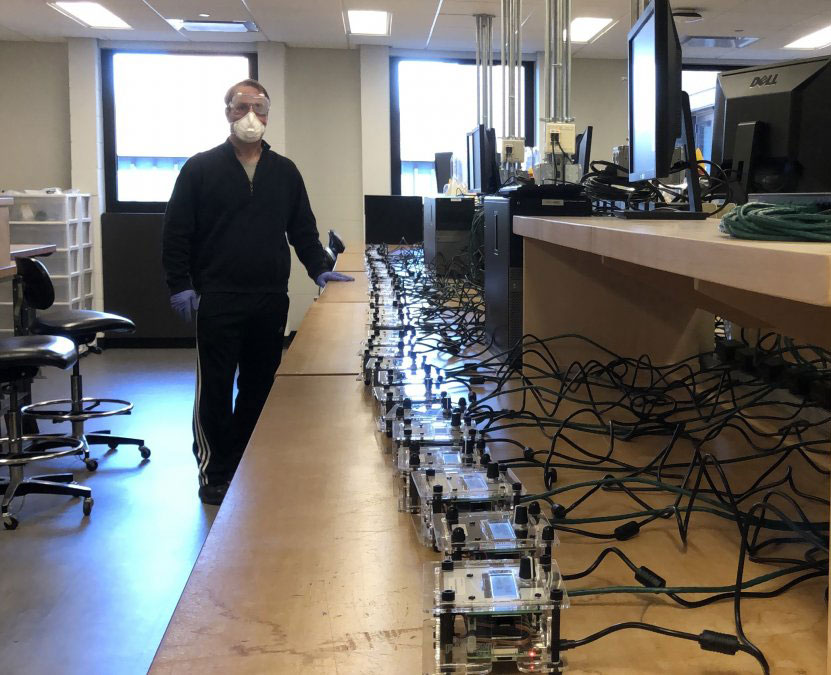
Professor Chris Tully tests a network of the first group of controllers.
Since the initial pandemic surge in the spring, treatment techniques and demands for equipment have changed. Manufacturers rapidly increased capacity and built hundreds of thousands of ventilators to supply hospitals at the same time doctors expanded available treatments for COVID-19. Although methods of treatment are evolving, the doctors at Penn Medicine were particularly interested in machines to safely deliver oxygen to patients who needed breathing assistance short of full intubation. With this type of breathing assistance, the patient is fitted with a clear flexible helmet over their head, and oxygen is delivered to the patient while the patient is awake and breathes normally. What was missing was a way to monitor the airflow, carbon dioxide, and measure the patient’s breathing. With the Princeton design, a flow meter would sit by each patient’s bedside, feeding data to a centralized panel where medical staff can monitor the conditions of many patients. The machines monitor the flow of oxygen to the patient and provide a detailed record of the patient’s respiration and other data to help doctors follow the progression of the disease.
“There was a realization in the medical community that ventilators were a method of last resort,” said Daniel Marlow, the Evans Crawford 1911 Professor of Physics. Penn was more interested in moving forward with flow meters. “So Andrew, I, Chris Tully, Dan Cohen and David Tank got started making flow meters for Penn.”
At its most basic, the flow meter is a pipe with sensors to read pressure differences at each end. The Princeton team, comfortable with building complex instruments for experiments, was able to create a design, but the challenge was adapting parts that were both available and affordable. The design and related information were made public for use by other researchers and medical workers.
“It had to be fast, and it had to be cheap,” said Howard Stone, the Donald R. Dixon ’69 and Elizabeth W. Dixon Professor of Mechanical and Aerospace Engineering, and the chair of the department. Stone and two postdoctoral researchers in his research group, Philippe Bourrianne and Janine Nunes, tested components to find those that were robust and effective over the range of flow rates used in medical treatment. “Because it’s used in a health setting, it has to be very reliable.”
Christopher Tully, a physics professor, designed the electronics that would control the device. Tully normally works on particle physics experiments at CERN and the Gran Sasso laboratory, but for this, he relied on sources closer to home.
“The first tests were a big lump of soldered wires that I did at home,” Tully said. “I used a lot of Radio Shack parts that I bought before the local store closed down a few years ago.”
Peter Elmer, a senior research physicist, led the software development team with computational physicists David Lange, Henry Schreiner and Jim Pivarski from his research group and associated to the Institute for Research and Innovation in Software in High Energy Physics (IRIS-HEP), which is based at Princeton. The software continually analyzes the raw signals and calculates quantities of interest to medical personnel such as the flow and average respiratory rates. It allows alarms to be set and also manages the flow of data from the monitor by the patient to the central monitoring panel.
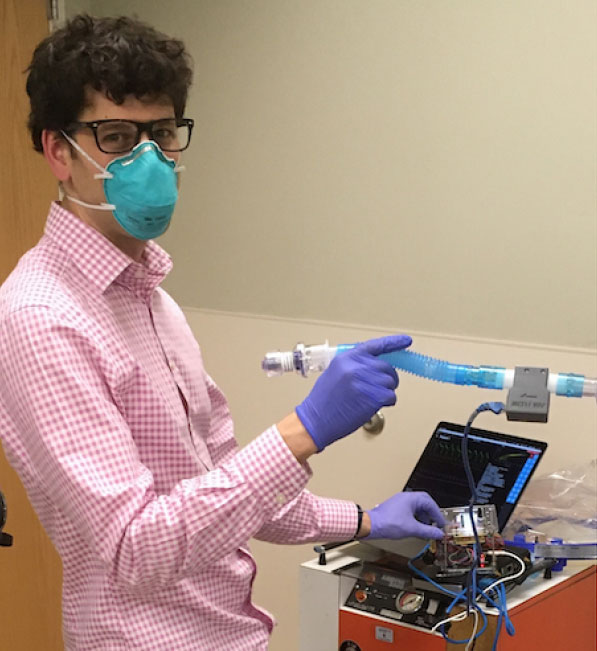
Assistant Professor Andrew Leifer with an early prototype of the monitor.
As Leifer worked to fine tune the design with experts at Penn, teams in University machine shops, including Al Gaillard in mechanical and aerospace engineering and Stanley Chidzik in physics, began to adapt parts and assemble circuit boards.
“When the parts are delivered here, they need to be assembled and aligned, which can be quite delicate,” said Bert Harrop, a senior technician at the Princeton Institute for the Science of Materials (PRISM) and the physics department. “PRISM has a packaging facility as well as imaging and nano-fabrication. The packaging lab is a nice tool to have for this kind of integration and building of parts and components.”
Craig Arnold, the Susan Dod Brown Professor of Mechanical and Aerospace Engineering and PRISM director, said: “The Institute is committed to assisting the community and the region during these unprecedented times. We are delighted to leverage our capabilities in the PRISM Cleanroom to contribute to this important project.”
As the basic assembly moved forward, the researchers tweaked the design as they received feedback from the doctors at the Penn.
“Typically, you don’t come out of R and D until you have a product,” Harrop said. “But this time, we were doing tests in the lab and making changes as we built the product.”
The work was made more challenging by the need to keep a safe distance among the scientists and techs building the machines. Contributors worked long hours, often in addition to teaching duties and other jobs. By May 1, the initial run of machines were ready to ship. The designers contracted with an assembly firm to produce another 400.
As the COVID-19 outbreak receded in New Jersey over the summer, the demand for the ventilation equipment eased, said Brenner, an assistant professor and attending physician at Penn. Although the helmet-based breathing system is being used in intensive care units, the demand did not reach the level that doctors worried might be necessary during the local peak in the spring. But Brenner said his colleagues are continuing their research with the system, including the respiratory monitors developed at Princeton.
“We decided to move forward with this because we are concerned about a resurgence — as the virus spreads in the community throughout the fall — and we want to be as prepared as possible for that,” Brenner said. “So we think that the helmet ventilation and the flow sensors, which are necessary to make it safe, are a key component of that.”
Elmer, Marlow and Leifer have been awarded an emergency grant from the National Science Foundation that will extend the development of low-cost and open-source monitoring as well as support studying how lungs operate when stressed by COVID-19. Their goal is to help medical professionals provide optimum care for patients being treated for COVID-19, to minimize both mortality and adverse long-term effects on survivors.
“We hope, with the broader community, open datasets of breathing data, and derived quantities of interest,” said Elmer, “this should enable innovation and machine learning in a space that otherwise lacks open data.”
Tests have shown the flow sensors perform comparably to commercial versions at a lower cost. When he received test results on the design, Marlow said, “I wouldn’t say I was surprised, but I would say I was pleased.”
“In my 20 years as a member of the Princeton faculty, this is the first opportunity I have had to engage across so many departments,” Tully said. “To see the group look beyond basic research questions to do whatever we needed to do to make the system work, has been an extraordinary experience. It reminded me how powerful the intellectual resources of the university can be in times of great need.”
